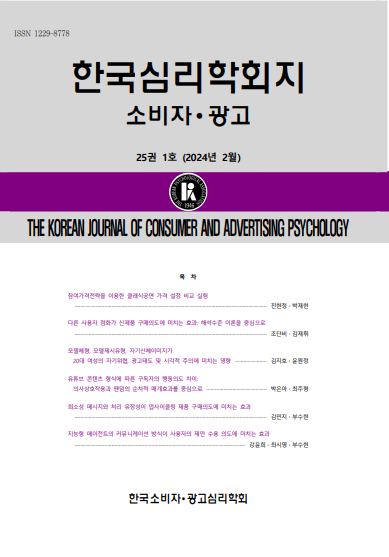open access
메뉴.png)
open access
메뉴 ISSN : 1229-8778
ISSN : 1229-8778
이 논문의 목적은 새롭게 주목받고 있는 소비자행복(consumer happiness)이란 개념을 측정할 때 사용할 수 있는 척도를 개발하고 타당화하는 것이다. 이 연구에서는 소비자행복을 “소비생활을 통한 행복체험”으로 정의하고, 개념적으로 정립된 소비자행복을 측정할 수 있는 척도를 탐색 연구와 확인 연구를 통하여 개발하고 타당화하였다. 개념적으로 정립된 소비자행복척도를 사용하여 서울특별시와 6대 광역시에 거주하는 성인 526명을 대상으로 자료를 수집한 다음에, 그 절반의 자료를 갖고 탐색 연구를 실시하고, 나머지 절반의 자료를 갖고 확인 연구를 수행하였다. 탐색 연구 결과는 소비자행복척도의 신뢰도와 타당도가 있음을 보여주었다. 내적일관성계수가 .8953으로 높게 나타났고 개념연구와 동일하게 3개의 요인이 추출되어 “문제해결적 행복요인”, “개인적합적 행복요인”, 및 “쇼핑연계적 행복요인”으로 명명하였다. 확인 연구는 공분산구조모형분석을 사용하여 탐색 연구에서 확인된 소비자행복의 구성요소들에 관한 모형을 설정하고 그 모형의 적합도를 검토하였다. 설정된 소비자행복척도에 대한 적합도의 전반적 지수가 높게 나타났기 때문에 소비자행복척도의 타당성을 확인할 수 있었다. 끝으로, 이 연구의 제한점과 앞으로 연구방향을 논의하였다.
The purpose of this study is to develop and validate an estimating scale that measures a newly noted concept called consumer happiness. In this study, consumer happiness is defined as “experiencing happiness through consuming activity,” and a conceptually founded scale that measures consumer happiness was examined and validated through exploratory study and confirmatory study. Data was taken from 526 adults living in Seoul and 6 other major cities in Korea with the conceptually founded consumer happiness scale. Half of the data, then, was used to perform exploratory study and other half of the data for confirmatory study. Results of exploratory study showed reliability and validity of the consumer happiness scale. Internal consistency coefficient showed high score of ,8953 and, in accordance with the conceptual study, “problem-solving happiness factor”, “person relevant happiness factor” and “shopping contingent happiness factor,” were extracted from the data as the three main factors. Confirmatory study, using covariance structural modeling, produced a model that confirms the three main factors of consumer happiness and verifies goodness of fit of the model. Since the fitness index of the produced consumer happiness scale has exceeded the minimum requirements, the validity of consumer happiness scale(CHS) was confirmed. Finally, limitations of this study and directions for further studies are discussed.
석만 (2008). 긍정 심리학: 행복의 과학적 탐구. 서울: 학지사.
남승규 (2009). 소비자분석. 서울: 학지사
남승규 (2010). 소비자 공감에 대한 이론적 연구. 한국심리학회지: 소비자⋅광고, 11(4), 619 -636.
남승규 (2012). 소비자 공감과 소비자 행복. 한국소비자학회 춘계학술발표논문집, 25-30.
박미혜, 이성림, 손상희, 정주원, 천경희 (2011). 소비생활에서의 행복과 갈등. 소비자학연구, 22(1), 139-167.
성영신, 유창조, 이진용, 박은아, 양윤재, 정수정 (2012). 소비유형별 소비행복의 비교. 한국소비자학회 춘계학술발표논문집, 233- 252.
황윤희 (2012). SK마케팅앤컴퍼니가 생각하는 고객의 행복과 MaiP: 고객의 행복까지도 읽는 지도 ‘MaiP’(Mashup Insight Pioneer). 한국소비자학회 춘계학술발표논문집, 264- 269.
Crawford, C. B. (1975). Determining the number of interpretable factors. Psychological Bulletin, 82, 226-237.
Csikszentmihalyi, M. (1990). Flow: The psychology of optimal experience. New York: Harper and Row.
Florida, R. (2010). The great reset: How new ways of living and working drive post-crash prosperity. New York: Harper Collins.
Holden, R. (2009). Be happy. Carlsbad, California: Hay House, Inc.
Huber, O. (1986). Decision making as a problem solving process. In B. Brehmer, H. Jungermann, P. Lourens, & G. Sevon(Eds), New directions in research on decision(pp. 109-138). North-Holland: Elsevire Science Publishers.
Keyes, C. L. M & Lopez, S. J. (2002). Toward a science of mental health: Positive directions in diagnosis and interventions. In C. R. Snyder and S. J. Lopez(Eds.), The handbook of positive psychology, 45-59. New York: Oxford University Press.
Layard R. (2005). Happiness: Lessons from a new science. New York: The Penguin Press.
Lyubomirsky, S. (2008). The how of happiness: A scientific approach to getting the life you want. 오혜경 (역). How to be happy: 행복도 연습이 필요하다. 서울: 지식노마드. (원서출판 2007).
Lyubormirsky, S., Sheldon, K. M., & Schkade, D. (2005). Pursuing happiness: The architecture of sustainable change. Review of General Psychology, 9(2), 111-131.
Reise, S. P., Waller, N. G., & Comrey, A. L. (2000). Factor analysis and scale revision. Psychological Assessment, 12(3), 287-297.
Rokeach, M. (1973). The nature of human values. New York: Free Press.
Schmitt, B. H. (1999). Experiential marketing: How to get customers to sense, feel, think, act, and relate to your company and brands. New York: Free Press, Inc.
Seligman, M. E. P. (2002). Authentic happiness. New York: Free Press.
Seligman, M. E., Rashid, T., & Parks, A. C. (2006). Positive psychotherapy. The American Psychologist, 61(8), 774-788.
Veenhoven, R. (2000). The four qualities of life: Ordering concepts and measures of the good life. Journal of Happiness Studies, 11, 1-39
